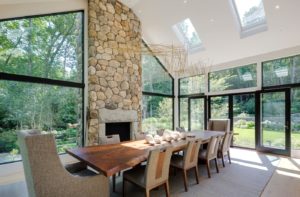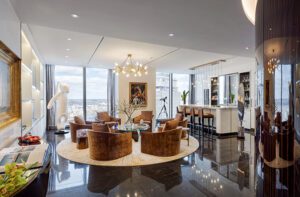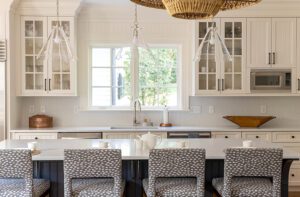An Artist’s Home in Litchfield County
July 27, 2018
A contemporary artist finds the perfect backdrop for his work—and his life—in a sensitively refurbished Colonial-era farmhouse.
Text by Bob Curley Photography by Laura Moss Produced by Karin Lidbeck Brent
Restoring a 250-year-old farmhouse appealed to artist Michael Quadland’s sense of nostalgia for his rural upbringing, his passion for historic preservation, and a simple need for more studio and gallery space. But it also had to do with a sense of permanence.
Growing up as the child of innkeepers, Quadland would sometimes come home to find his room rented to strangers, relegating him to the couch for a night or two. The restored farmhouse in Morris, however, is truly his; in fact, he is only the home’s third owner since it was built by the Benton family in 1767. “Something about this place is so stable,” he says. “To me, it’s a real home.”
Actually, it’s more than that. Quadland lives in the original eighteenth-century house, but, with the help of builder Ben Buck of Benovation, he transformed a barn-sized attached workspace—once used to sort eggs and repair farm machinery—into a studio.
Further blurring the lines between home and work, Quadland painted most of the farmhouse’s walls white, creating a gallery-like atmosphere for displaying his large-format, three-dimensional paintings throughout the home.
The choice to hang the works in the dining room, living room, and elsewhere in the house is more than just pride. Quadland frequently walks prospective clients through his home to demonstrate how his works of abstract modern art can complement even the most traditional home. “Colonials were all about function—they couldn’t afford a lot of adornment,” he says. “My work is the same way, so I think they go well together.”
Even as a child, Quadland loved art and was fascinated by industrial design and building structures. Both help inform his work, which often incorporates geometric shapes and scraps of old metal. After a thirty-year career working as a psychologist in New York City (“My family thought I needed to do something more serious,” he explains), he returned to art about a decade ago, working out of a home and studio in Litchfield. (His work was featured in “Artistry” in the Summer 2017 issue of New England Home Connecticut.)
On the day he first came across the Morris farmhouse, he was only searching for more studio space, not a new home. “I wasn’t looking to take on a project, but when I saw the house, I could not resist,” he confesses.
Sitting atop a hill with views of the Berkshire Mountains and surrounded by 250 acres of farmed conservation land, the 2,800-square-foot home was private and sturdy despite its years. “It needed a great deal of work, but everything was still there,” Quadland says, including the original flooring, paneling, and fireplaces. “We kept the old part of the house as it was, and restored it. I didn’t feel the same sense of obligation about the barn, because it already had been extensively changed in the 1960s,” when it was converted into a four-bedroom apartment for the owners’ children.
The restoration of the house included stripping layers of paint and adding a new coat of whitewash to walls and a high-gloss white finish on the floors. Woodwork that could not be repaired was replaced with period-appropriate materials; centuries-old boards taken from a removed attic wall become the top of the dining room table.
The goal was to retain the home’s historic character while creating an atmosphere that was bright, clean, and crisp. “Executing Michael’s vision was a good kind of challenge,” says Buck, especially when it came to renovating the bathrooms to appear old fashioned while functioning to modern standards.
Furniture is a mix of family heirlooms (Quadland says his grandfather paid a quarter at a yard sale for the brass bed in the upstairs bedroom), antiques, and various pieces collected here and there, including keepsakes like a carved owl from the early twentieth century and sculptures by other artists. Country-style chairs are paired with tables of metal and wire mesh, illustrating Quadland’s successful union of traditional and industrial design.
Of course, like any old home, the Morris farmhouse held its secrets. Under one rug, Quadland and Buck found a gap through which they could see into the basement. When they pulled up another, they found that the paint on the floor didn’t extend past the fringes. “In the center was raw wood: for 250 years, they had never painted under the rug,” Quadland says.
As the work proceeded, reminders of the home’s past inhabitants surfaced: old games, coins, newspapers, family photos, a ring. Some trinkets and old machine parts have found their way into Quadland’s artwork, helping to seal the connection between the former and present occupants.
Apart from replacing the roof, structural work on the historic home was minimal: just a single wall was taken down upstairs to create a master bedroom from two smaller spaces, and the floor in the breakfast room had to be reinforced to support a concrete-topped table.
The barn was a different story: it was gutted, removing all trace of the apartment, and a wall of windows was installed to brighten Quadland’s new workspace. “Creating the studio was really fun for me, because it’s where I spend most of my time,” he says.
Quadland and Buck worked side by side on the restoration project for six months, sometimes using Quadland’s antique, but still functional, 1966 Ford F-100 pickup truck to haul supplies. “Maybe it’s my Yankee upbringing, but I grew up in a family where we did a lot of work ourselves,” he says. “If you could do it, you did.”
He also appreciated the immediate rewards involved in the restoration, where goals could be met in days rather than the months it takes to complete some works of art. “I find that gratifying at the end of the day you can see what you’ve done,” he says.
Janet Towle, a daughter of the former owners, grew up in the Morris farmhouse and was invited to tour the property when the renovation was completed. “We could not be more thrilled,” she says. “This is a 250-year-old farmhouse that Michael has renovated and repurposed for the twenty-first century. He’s very sensitive to the history of the house, and we’re very grateful for that.”
Share
![NEH-Logo_Black[1] NEH-Logo_Black[1]](https://www.nehomemag.com/wp-content/uploads/2022/08/NEH-Logo_Black1-300x162.jpg)























You must be logged in to post a comment.